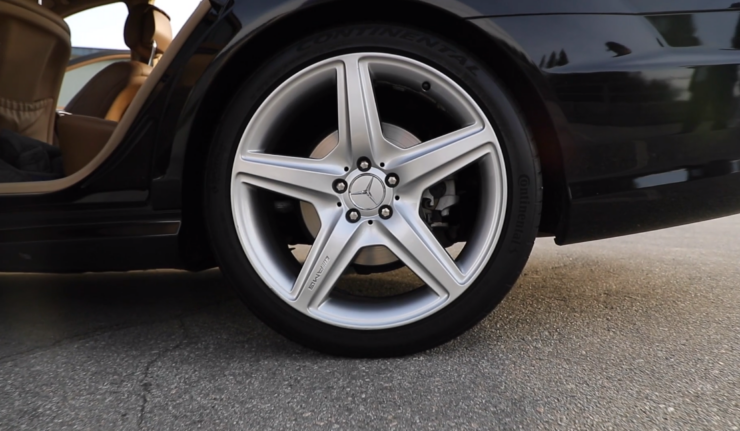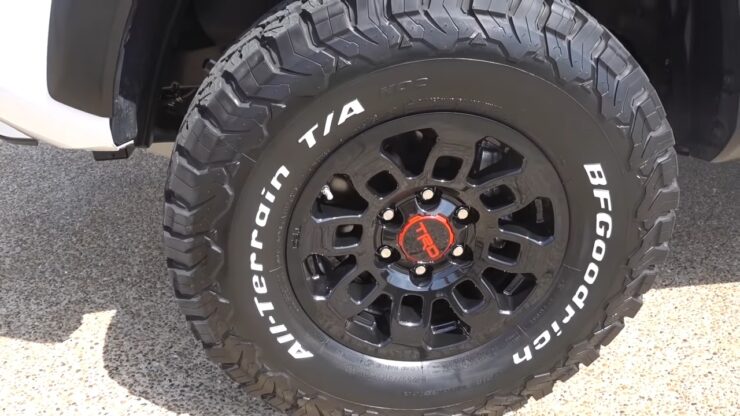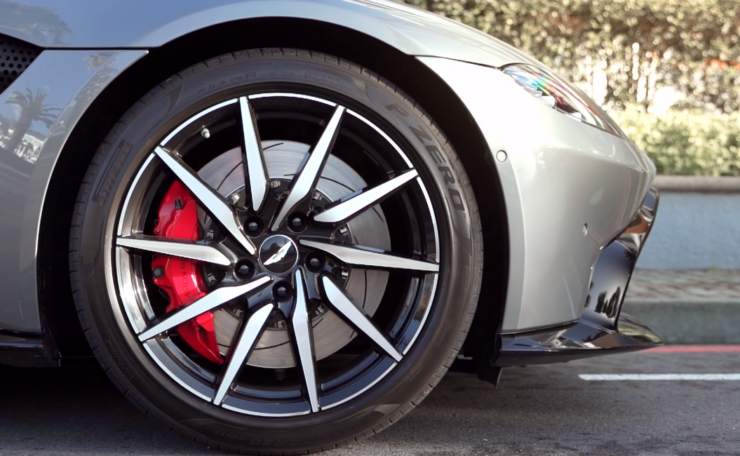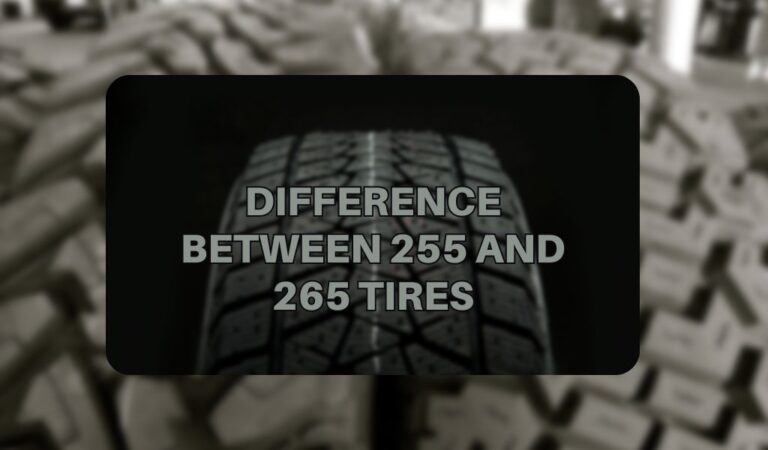Whether 255 or 265, the size of tires you are using on your car matter. However, many of us give little thought to the size of tires that we use on our cars.
Tires come in different sizes. Although you can use different sizes of tires on your vehicle, this can be costly and sometimes dangerous. We must understand the sizes and their meaning before choosing which tires we can put on our car.
Some of us are more interested in small and others in bigger size tires. But, have you ever asked yourself which size is better for your vehicle?
Which tires for which vehicle?

The size of wheels you pick for your vehicles should always be the best fit. It is to give the best contact of your car to the ground. As someone would tell you, the best the grip your tires have with the ground, the more stability your vehicle has on the road.
Bigger wheels equal bigger cars. The larger the rim of your car, the larger the size of tire your car can use. However, for most light pickups, SUVs, and passenger cars weighing ½ ton and below, the tires are marked as either p-Metric or Euro-Metric. As said before, both metrics are suitable for any passenger vehicle, including personal cars, SUVs, minivans, and light pickups.
If your vehicle does not fall under these two metrics, especially vans and larger pickups weighing up to ¾ tons, two categories are common; “LT” and “ST” metrics. LT-metrics is meant for light trucks, while ST-metrics is meant for special trailers.
Regardless of which type of metric you are using, a size chart can help find the tire size best fits your vehicle.
Different tire sizes
Different sizes of tires are meant to fit different types of cars. There are many sizes, from small to larger sizes. However, the most popular tire sizes are 33 inches, 35 inches, 37 inches, 255/45R20, 265/45R20, 275/70R18, and 285/70R17.
These are well noted on the sidewalls. Each tire numbers and letters denote the width, height of the sidewall ratio, and the diameter of the wheel.
Features and specifications of 255 tires
The 255 tires are meant to withstand more load. Its features and specifications include:
- Load range: H
- Rim Width: 7.5 inches
- Diameter: 36.7 inches
- Thread depth: 18
- Speed rating: 81 mp/h
- Revs per mile: 566
- Single maximum load: 2,500 Kilograms
Features and specifications of 265 tires
- Load range: G
- Rim width: 7.5 inches
- Diameter: 38.9 inches
- Thread depth: 20
- Speed rating: 75 miles per hour
- Revs per miles: 534
- Single maximum load: 2,360 Kilograms
Differences between 255 and 265 tires
There are notable differences between these two tire sizes. Key among these are weight, gas mileage, the number of car loads each can sustain, stability, and maneuverability. However, there is little difference in their width. At the same time, their diameter sizes are different.
#1. Weight

The weight of 255 tire size is 42.722 kilograms. On the other hand, 265 size measures slightly higher, reaching a maximum weight of 45.891 kilograms.
The weight of each tile is important when choosing which type best fits your car. Although one changes the rims of 255 to fit 265 in their vehicle, subsequent change of weight of the tires can affect the speed and overall road performance of your vehicle.
You mean that using a 265 tire will make your car heavier, slowing down its speed. If your car is lighter but still has options to choose which one to use, go for the lighter one if you are looking for speed.
#2. Overall gas mileage
The heavier the tires, the more fuel they will consume. Therefore, the amount of gas required by your vehicle while using a 265 size is higher than 255 sizes.
To make sense of this, we look at the tread size of the two. The thread depth of 255 is 18, compared to 20 for a 265 size. Vehicles using 265 sizes require more effort compared to 255 sizes. The effort will then translate to more fuel consumption.
Using 255 sizes is more economical in terms of fuel consumption than 265 sizes.
#3. Amount of load endured
The maximum amount of load that a single 255 tire can sustain is 2,500 kilograms. It compares to the 2,360 kilograms that a single 265 tire size can hold. It means that 255 tire sizes can endure more weight compared to 265 tire sizes.
Therefore, it is important to consider what you want to do with the vehicle and the right amount of load you will be carrying while choosing between the two. For heavier loads, you can go for size 255, while 265 can still sustain a considerable amount of weight, though lower than 255.
To understand the amount each size can endure, look for information given by the load index on the sidewall of each tire.
#4. Stability
The stability of your vehicle is very important while you are running on the road. The larger the tires are, the more stable your car will be. It is also crucial for fast drivers or when driving on rough roads. Wider tires will give you that extra stability and keep you out of danger.
With an extra 10 mm width, 265 is wider and can provide you with the required stability. Although a 10 mm difference might seem small on the eyes, it makes a huge difference when giving your desired stability when speeding.
#5. Maneuverability
The size of your tires is critical for the grip your car has on the road. An increase in tire width ensures that you cover more surface area. It also gives your car a higher amount of hold to the ground, increasing your capability to maneuver.
Therefore, in our case, 265 tire size is considerably bigger than 255 tire, which automatically tells us that it gives more opportunity for the driver to maneuver. Therefore, if you like trying new things on the road, you would probably go for 265 tire size.
Pros and cons of 255 and 265 tires
In the real comparison, it is easier to note significant differences between the two tire sizes. However, each of these two also has its advantages and also disadvantages. The concept of 265 been bigger than 255 does not automatically make them superior.
Pros and Cons of 255 tire size
- Has good fuel mileage
- Cheaper
- Great height
- Higher load endurance
- Low grip leading to poor stability
- Low maneuverability
Pros and Cons of 265 tire size
- Good stability for fast driving
- Higher maneuverability
- Attractive on the look
- Expensive- bigger wheels equal to bigger price tags
- Higher fuel consumption rate
Looking at some of the frequently asked questions on google about 255 and 265 tire sizes would work as an ultimate suggestion for you to pick the right choice between these two.
Frequently Asked Questions

What difference will I have using 255 instead of 265 tires?
Despite the 255 and 265 sizes appearing to be the same on the eyes, there is considerable differences between them. It has a 10 mm difference in width.
Though this may seem small, it is high enough to make a difference while driving your vehicle at high speed.
Is it possible to use 265 tires instead of 255?
Yes, you can use these two interchangeably. However, there are certain effects your car will have in terms of its performance. Among these is the speed of your vehicle. Using a bigger tire size will slow your vehicle down due to the weight differences between the two.
If you think 255 is good enough, then no need to replace them. Of importance here is noting that the external diameter that indicates how many times the tire travels in a single revolution is slightly lower for 255 sizes than 265 sizes.
It is therefore wise to use the correct size for your vehicle.
Is 265 taller than 255 tire size?
Although the height might vary, going to 265 from 255 raises your vehicles by approximately 14mm higher.
Should I go for 265 or 255?
You will be ok with 1o mm wider. Although this means using a higher amount of gas, you have more grip on the road. It is especially paramount if you are looking to get more stability on the road.
Can 265 fit 255 rims?
That is possible if the measurement of both sides is the same. However, you cannot do it only on one side.
What do 255 and 265 on tires mean?
255 and 265 represent the width of the tires in mm.
What change will you have moving from 255 to 265 tire sizes?
The main change you will experience by moving from 255 to 265 is on the speedometer. The speed will reduce.
Can I use 265 tires instead of 255?
Yes, you can use 265 tires instead of 255, but there are certain effects on your vehicle’s performance to consider. Using a bigger tire size can make your vehicle heavier and slower due to the weight differences. It is also important to note that the external diameter, which indicates how many times the tire travels in a single revolution, is slightly larger for 265 sizes than 255 sizes.
Which tire size is better for my vehicle, 255 or 265?
The best tire size for your vehicle depends on various factors, such as the type of vehicle, driving conditions, and personal preferences. Generally, 265 tires provide better stability and maneuverability, while 255 tires offer better fuel mileage and load endurance. It is recommended to consult a tire specialist or refer to your vehicle’s owner manual to determine the best tire size for your vehicle.
What do the numbers on the tire size mean?
The numbers on the tire size represent the width, aspect ratio, and diameter of the tire. For example, in tire size 255/45R20, 255 represents the width of the tire in millimeters, 45 is the aspect ratio (the height of the sidewall as a percentage of the width), and 20 is the diameter of the wheel in inches.
How do I know which tire size is compatible with my vehicle?
The best way to determine which tire size is compatible with your vehicle is to refer to your vehicle’s owner manual or consult a tire specialist. The owner manual provides the recommended tire size and specifications for your vehicle, while a tire specialist can provide expert advice on the best tire size for your specific driving needs and preferences. It is important to use the correct tire size for optimal performance, safety, and durability.
Conclusion
Both 255 and 265 have their pros and cons. While 265 gives a wider area to cover compared to 255. However, you cannot consider the 265 upgrades of 255 tire size. Customer satisfaction over these two varies considerably.
All that matters is what you are looking to have in your car. If you are looking for fancy look in your vehicle, you will go for the 265 tire size. If you are a regular person and want your ride to match daily life, you can stick to 255 sizes.
Related Posts:
- Difference Between 265 and 275 Tires in 2024 - Let's…
- Difference Between Lexus ES and GS - Which One is…
- Difference Between 265 and 285 Tires - Choosing the…
- Difference Between 275 and 305 Tires - Know Which is…
- Difference Between 275 and 285 Tires in 2024 -…
- Difference Between 285 and 295 Tires in 2024- Which…













